AJKOER
Radically Dubious
    
Posts: 3026
Registered: 7-5-2011
Member Is Offline
Mood: No Mood
|
|
Every Home’s Chemistry: Guide to Dissolving Copper Metal
Disclosure: Home Chemistry I am defining as the realm characterized by generally impure and dilute reagents that are commonly available at low cost
with no questions asked. Caution, the province of Home Chemistry is not without its issues including increased complexity and its products can, at
times, be essentially problematic depending on the intended use, or from resulting alterations in properties. For example, for those working with
synthesized oxidizers, created at home, any induced presence of transition metal impurities, or organics, may result in excessively sensitive
explosive mixtures. As another example, the incidental introduction of a methyl impurity, could create products with greatly extended poisonous
properties. As such, in my opinion, even greater safety protocols should be in place and a careful review of possible underlying chemistry (which can
be quite advanced as a reading of the material below suggests), which should be conducted in advance and seeking advice as needed,
CHAPTER ON DISSOLVING COPPER METAL
I give an example of a microwave assisted experiment creating a copper salt from household vinegar ( 5% acetic acid, HAc, from 360 ml of 5% household
distilled white vinegar), a small piece of copper (as sourced from a 1 inch long pure copper plumbing tube, which interestingly may contain a very
small amount of Silver, see https://www.copper.org/applications/plumbing/techref/tpf_std...), dilute 3% hydrogen peroxide, H2O2, (120 ml) which often have an additive of
nitrate and H3PO4 (see https://www.using-hydrogen-peroxide.com/food-grade-hydrogen-...), sea salt, NaCl, (15 ml as sold in stores as a condiment) and a carbon source,
C, (in the form of carbonized toast where ideally, the surface area of the carbon should greatly exceed that of the surface area of the copper
metal, also relatedly, see comment and source link at http://www.sciencemadness.org/talk/viewthread.php?tid=70570#... ). See pictures below.
General comments include that heterogeneous chemistry (as, in this experiment, even distilled white vinegar is not pure acetic acid), can be more
daunting than homogeneous chemistry. Also, the fundamental nature of the synthesis is, in part, standard chemistry as well as electrochemistry and
more. More recently, the use of a microwave in the presence of carbon has been noted in the literature as leading to the formation of powerful
radicals, so this is more properly viewed, in my opinion, as a microwave assisted electrosynthesis as well (see, for example, “Generation of
hydroxyl radical in aqueous solution by microwave energy using activated carbon as catalyst and its potential in removal of persistent organic
substances” at https://www.researchgate.net/publication/239705822_Generatio... ). The presence of acidic radicals may also be of consequence (see
‘Radical-Enhanced Acidity: Why Bicarbonate, Carboxyl, Hydroperoxyl, and Related Radicals Are So Acidic’ at https://pubs.acs.org/doi/abs/10.1021/acs.jpca.7b08081?src=re... and also https://pubs.acs.org/doi/abs/10.1021/jp984769y?journalCode=j... and my prior comments on SM at http://www.sciencemadness.org/talk/viewthread.php?tid=94166).
The expected product in this synthesis include the possible formation of numerous greenish copper complexes due to the high concentration of the
chloride ion from the added sea salt. To quote from Wikipedia on CuCl2 (https://en.wikipedia.org/wiki/Copper(II)_chloride ):
“Aqueous solution prepared from copper(II) chloride contain a range of copper(II) complexes depending on concentration, temperature, and the
presence of additional chloride ions. These species include blue color of [Cu(H2O)6]2+ and yellow or red color of the halide complexes of the formula
[CuCl2+x]x− “
To alleviate any questions arising as to the precise impact of the carbon presence in the microwave assisted electrosynthesis, I repeated the
experiment with the same quantities of reagents except I used a smaller piece of copper and no carbon.
OBSERVATIONS AND RESULTS
Pictures at various times during the reaction suggest major differences. First, there is much more gas bubbles presence after the initial 2 minute MW
treatment with a H2O2/O2/Cu/HAc/NaCl cell as compared with MV assisted carbon based run. For the carbon free experiment, reheating after an hour
resulted in no significant self-sustaining bubbling action at all (in essence the H2O2 was likely completed exhausted, and as H2O2/O2 is one of the
half-cell reactions, no further copper dissolution would be expected). Apparently, the carbon free experiment produced a much more diluted solution
along with a light colored powder coating the bottom of the vessel, which is in obvious contrast to much deeper olive green color along with a
particle suspension at the bottom of the carbon run in a zone about ¼ inch high exhibiting apparently greater viscosity (supporting the particle
suspension).
DISCUSSION OF POSSIBLE ELECTROCHEMISTRY, SURFACE CHEMISTRY AND RADICAL REACTIONS
Generally, the anode is the electrode (or zone) where galvanic reaction(s) generate electrons and where anodic corrosion typically is observed.
Correspondingly, the cathode is the electrode that receives electrons and is protected from electrochemical based corrosion.
Some of my expected half cell reactions in this experiment:
Anodic Zone:
Cu ⇌ Cu+ + e- -0.52
Product includes Cu2O which decomposes H2O2 releasing O2 (see below) and also the Cu2O can react with acetic acid in a standard chemical reaction
forming copper(I) acetate.
2 H2O2 --Cu2O→ 2 H2O + O2
The action of the microwave (MV) on the carbon likely forms surface areas containing a deficiency and excess of electrons (it is also an area of
ongoing research, see, for example, https://www.sciencedirect.com/science/article/pii/S187853521... ):
C(surface) + MV → C(+) + e-
Cathodic Zone:
H2O2 ⇌ H+ + HO2-
e- + H+ = H.
This can be followed by an attack on the H2O2 leading to radical formations (see http://www.ipb.pt/~htgomes/FCT110088-%5B2%5D.pdf equations (3) and (4), in particular). My take is as follows:
H. + HO2- = OH- + OH•
OH• + H2O2 ---> HO2• + H2O (see https://pubs.acs.org/doi/abs/10.1021/jp100204z )
The acidic nature of the HO2• (perhydroxyl radical) has been previously noted above.
Some recycling of the H2O2 may be possible from the liberated oxygen and radical reactions in the presence of microwaves and an appropriate carbon
source:
OH• + OH• = H2O2
HO2• + HO2• = H2O2 + O2
O2 (g) + 2 H+ + 2 e- ⇌ H2O2 + 0.70
See, for example, http://jes.ecsdl.org/content/76/1/359.short.
I suspect electrons from the anodic zone can be electrostatically attracted to, and can be collected on, surface areas of the carbon electrode having
an electron deficiency (which I referred to as C(+)) possibly allowing the previously cited carbon surface reaction above to recycled with further MV
treatment:
C(+) + e- --> C
As a reference on the collection of electrons on the carbon electrode, see, for example, discussion on zinc-carbon battery at https://en.wikipedia.org/wiki/Zinc%E2%80%93carbon_battery ). Also to quote from studies on activated carbon (AC):
“Additionally, at pH 3, ACb and ACo surfaces are positively charged (see pH(pzc) values in Table 3), and therefore adsorption on these samples may
be enhanced via electrostatic attractions,....” (see p. 740 t http://www.ipb.pt/~htgomes/FCT110088-%5B2%5D.pdf )
I would further mention it is possible that above radicals also attacked the acetic acid itself resulting in organic breakdown products which may or
may not contain Cu.
--------------
One reason for the carbon presence to apparently lead, as is suggested visually, to an increased copper ions presence, is that the more noble carbon
electrode may be resulting in a battery cell with a higher voltage output along with converting some microwave energy into solvated electrons and
associated beneficial radicals via carbon surface reactions.
CONCLUSION
An apparent suggested conclusion is that for dissolving metal copper in dilute acetic acid, dilute H2O2 and sea salt, employing a microwave assisted
electrosynthesis with a form of activated carbon may produce better yields with a given amount of reagents.
[Edited on 16-6-2019 by AJKOER]
[Edited on 16-6-2019 by AJKOER]
|
|
|
AJKOER
Radically Dubious
    
Posts: 3026
Registered: 7-5-2011
Member Is Offline
Mood: No Mood
|
|
This a starting picture of the carbon free approach following a 2 minute microwave treatment. Note the with pronounced apparent release of O2, which
nevertheless resulted eventually in a much lower visible copper ion presence.
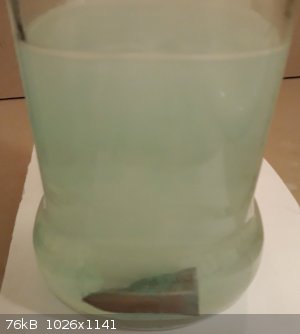
[Edited on 16-6-2019 by AJKOER]
|
|
|
AJKOER
Radically Dubious
    
Posts: 3026
Registered: 7-5-2011
Member Is Offline
Mood: No Mood
|
|
This is the actually starting solution mix of the carbon run (note the longer piece of copper employed) which actually displayed some activity before
even heating it in the microwave for 2 minutes. The color reflects the presence of the carbon source.
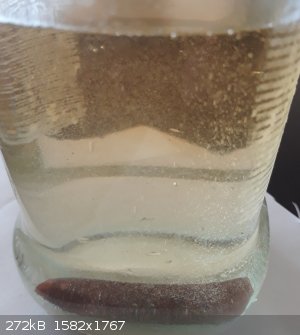
Other files to follow as get them to conform to posting dimensions.
[Edited on 15-6-2019 by AJKOER]
|
|
|
AJKOER
Radically Dubious
    
Posts: 3026
Registered: 7-5-2011
Member Is Offline
Mood: No Mood
|
|
This is the final image with carbon run. Note, the intense color.
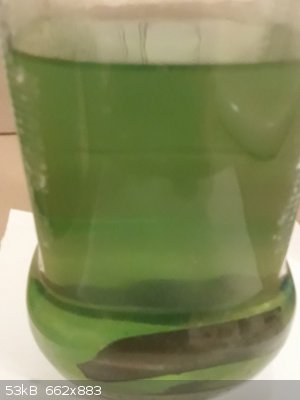
[Edited on 15-6-2019 by AJKOER]
|
|
|
AJKOER
Radically Dubious
    
Posts: 3026
Registered: 7-5-2011
Member Is Offline
Mood: No Mood
|
|
This is the final picture of the run without carbon.
A few points, the vessel is place half on a white background to make visible the white salt. Also, the light coloration.
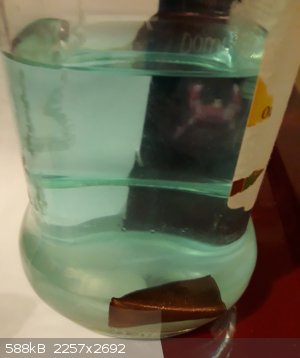
[Edited on 16-6-2019 by AJKOER]
|
|
|
AJKOER
Radically Dubious
    
Posts: 3026
Registered: 7-5-2011
Member Is Offline
Mood: No Mood
|
|
Some starting materials:
Copper tubing (the large piece) and the carbon source (best viewed by repeated clicking the picture to magnify the size).
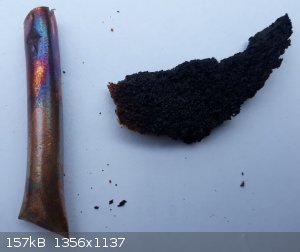
[Edited on 16-6-2019 by AJKOER]
|
|
|
AJKOER
Radically Dubious
    
Posts: 3026
Registered: 7-5-2011
Member Is Offline
Mood: No Mood
|
|
I now depart from using organic acids to inorganic NaHSO4 (10 ml , which is commonly available as a pH adjuster for spas), along with 3% H2O2 (240
ml), NaCl (5 ml) and my constructed carbon electrode. I applied a single 2 minute microwave treatment to this carbon electrode mix. See pictures
attached below.
MECHANICS OF REACTION
Radical reactions as before along with possible sulfate radical as I have detailed in a prior thread.
My take is as follows:
Cu = Cu(l) + e- (aq)
Cu(l) = Cu(ll) + e- (aq)
H2O2 = H+ + HO2-
H+ + e-(aq) = •H
•H + HO2- = •OH + OH- (see relatedly https://www.sciencedirect.com/science/article/pii/S016612800... )
H+ + OH- = H2O
•OH + HSO4- = H2O + •SO4- R8 (see below reference)
•SO4- + e-(aq) = SO4(2-)
----------------------------------------
Net: Cu + H2O2 + H+ + HSO4- --> Cu(ll) + SO4(2-) + 2 H2O = CuSO4 (aq) Expected k > 10^8 (based on p. 15 reported reactions by •SO4- acting
on Fe(ll), Ce(lll), Cr(ll),.. at https://srd.nist.gov/NSRDS/NSRDS-NBS-65.pdf by Ross and Neta)
Now, the application of microwave energy to activated carbon surface in the presence of H2O2 (as implied per above, results in the one electron
reduction of H2O2) should augment radical activity:
C(surface) + MV → C(+) + e- (see https://www.researchgate.net/publication/239705822_Generatio... )
e- + H2O2 = •OH + OH-
Also, per this source Table 4.2, on Page 130, https://tel.archives-ouvertes.fr/tel-02057515/document (warning, a large file), a host of interesting radical reaction that could account for the
augmented performance of this preparation path, including:
•H + SO4- = •HSO4- R9
•SO4- + •SO4- = S2O8 (2-) R10
•SO4- + •OH = HSO5- R11
•SO4- + •HO2 = HSO4- + O2 R13
HSO5- + •H = •SO4- + H2O R15
I see the creation of the powerful oxidizing HSO5-, S2O8(2-), along with formation of O2 and recreation of HSO4-.
The actual time to produce the 2nd to last intense coloration picture below was under 10 minutes.
No significant SO2 smell detected and previously visible small carbon particles appear to have been converted to CO or CO2.
-------------------------------------
Found an article (see https://onlinelibrary.wiley.com/doi/abs/10.1002/jcb.24030030... ) to quote:
"Furthermore, we found that HOCl/OCl− is generated in solutions of H2O2 and Cu2+ in the presence of 0.5 M NaCl"
This implies once cupric is formed, in the presence of H2O2 and NaCl, some HOCl is formed. Given the following fenton-type reactions:
Cu(l) + HOCl --> Cu(ll) + .OH + Cl-
And, I suspect:
Cu + HOCl --> Cu(l) + .OH + Cl-
even more radical creation (and copper dissolution) could result.
[Edited on 16-6-2019 by AJKOER]
|
|
|
AJKOER
Radically Dubious
    
Posts: 3026
Registered: 7-5-2011
Member Is Offline
Mood: No Mood
|
|
The picture on the far right is the starting NaHSO4/H2O2/Cu/NaCl/C mix with the dark color associated with the prepared carbon electrode.
The other picture is taken minutes after the 2 minute microwave treatment.
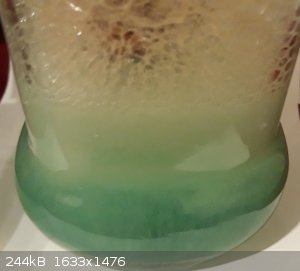 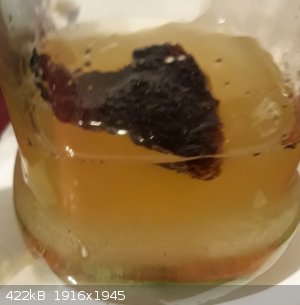
[Edited on 16-6-2019 by AJKOER]
|
|
|
AJKOER
Radically Dubious
    
Posts: 3026
Registered: 7-5-2011
Member Is Offline
Mood: No Mood
|
|
This picture of the NaHSO4 mix follows a few minutes latter.
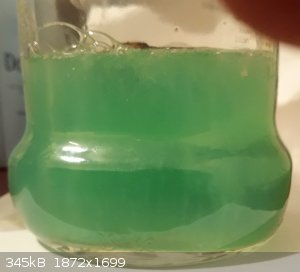
[Edited on 16-6-2019 by AJKOER]
|
|
|
AJKOER
Radically Dubious
    
Posts: 3026
Registered: 7-5-2011
Member Is Offline
Mood: No Mood
|
|
Final picture of the NaHSO4/H2O2/Cu/NaCl/C mix after applying a second 2 minute microwave treatment. Not much bubbling. Note the intense coloration.
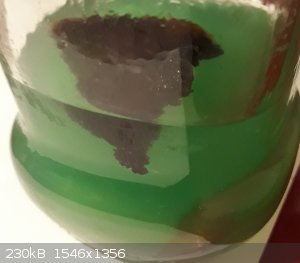
[Edited on 16-6-2019 by AJKOER]
|
|
|
Ubya
International Hazard
    
Posts: 1247
Registered: 23-11-2017
Location: Rome-Italy
Member Is Offline
Mood: I'm a maddo scientisto!!!
|
|
But, purpose?
You dissolved some copper in solution together with many other ions, in what application this could be useful? Generic dissolution of E-scrap maybe?
I'm more a practice guy, if I want copper in solution I want to do something with it maybe, but you now have quite a complex solution of copper and
various other ions that can interfere in many ways.
Plus I know you cite many papers and sources, and that's wonderful, but I don't think it's fair to compare your work to what all those other did,
because there is a major difference. You are more of a theory guy I guess, but all those proposed mechanisms don't convince me 100%, one for sure
because during my chemistry degree we don' t discuss much about radicals yet, so I'm not familiar, two because I can't see enough data, to propose a
theory you need lot's of data, your paths could be easily proven or disproven by a few tests (not just visual tests like "it's greener"). Amateur
chemistry is most of the time centered to preparations, and techniques, because to study a reaction mechanism and have proofs of it most of the time
requires many expensive tests (IR spectroscopy, NMR, XRF, UV-Vis spectroscopy, calorimetric measurements, etc etc).
---------------------------------------------------------------------
feel free to correct my grammar, or any mistakes i make
---------------------------------------------------------------------
|
|
|
AJKOER
Radically Dubious
    
Posts: 3026
Registered: 7-5-2011
Member Is Offline
Mood: No Mood
|
|
My final 'test' is, for example, in the tentative application below, would be the amount of pure KClO3 crystals I have obtained.
--------------------
My CuSO4 solution, per a discussion on another thread, may be suitable to create some Cu(OCl)2 by mixing with NaOCl in excess and freezing out the
Na2SO4 hydrate.
The new mixed hypochlorite solution, I suspect (based on my postulated chemistry of why some hypochlorite are more air sensitive, which as far as I
know, has not been addressed in the literature, where my answer is creation of the superoxide radical anion and subsequent reactions leading
eventually to chlorate), will be more prone to chlorate formation.
To quote from that thread (see http://www.sciencemadness.org/talk/viewthread.php?tid=150965 ):
Quote: Originally posted by AJKOER  |
My recent expansion in knowledge suggests to partially acidify aqueous Mg(OCl)2 (or Ca(OCl)2) with CO2, apply mild heat, O2 and sunlight. Both MgCO3
and CaCO3 suspension in sunlight are photocatalyst capable of inducing needed radicals especially, the hydroxyl radical.
A simple alternate path to introduce the hydroxyl radical is periodic low dosing with H2O2 (which decomposes ClO- eventually leading to O2 (which I
would keep in the system) but apparently the reaction commences with some .OH creation (see https://www.researchgate.net/publication/230651663_Hydroxyl_... ). Cited reaction (1):
OCl- + H2O2 --> .OCl + .OH + OH- (1)
I may soon try the action of microwaving (MW) on a form of activated carbon (AC) in an acidified hypochlorite in the presence of oxygen. Logic, the
action MV on the carbon surface forms zones of excess and deficiency in electrons:
C(surface) + MV = C(+) + e-
O2 + e-(aq) = .O2- (aq) (the superoxide radical anion)
.O2- + HOCl = .OH + O2 + Cl- (see Eq 2 at http://protein.bio.msu.ru/biokhimiya/contents/v78/pdf/bcm_14... )
The superoxide would likely have a longer half-life in the presence of ions of Al, Mg or Ca (see below). One may consider the action of O2 converted
to superoxide reacting with hypochlorous acid resulting in the hydroxyl radical precursor as an explanation as to why certain bleaches (like Mg(OCl)2)
are claimed to be more sensitive to air exposure leading to decomposition/chlorate formation.
An alternate path to .OH absence O2 may proceed as follows in the presence of solvated electrons:
HOCl + e-(aq) = .OHCl-
The above radical may breakdown depending on pH above or below 5 as follows:
.OHCl- --> .OH + Cl- (pH > 5) (Source: Supplement Table S1 at: http://www.mdpi.com/1420-3049/22/10/1684 and click on Supplement F1 to download)
.OHCl- --> OH- + .Cl (pH <5) (Source: Supplement Table S1)
----------------------------------------------
Mg(OCl)2 can be sourced from mixing common sodium hypochlorite (pool strength is available in grocery stores in more southern states) and Epsom Salt
(actually, a very pure MgSO4 hydrate as people take baths in Epsom Salt and could ingest through the skin heavy metals if not pure) is a good start. I
recommend freezing out the Na2SO4 as the SO4- ion will scavenge valuable hydroxyl radicals needed for chlorate formation.
My reasons are, in addition to purity, I recall a patent claiming problematic chlorate formation as Mg(OCl)2 is apparently more sensitive than NaOCl
in converting to chlorate on warming (like 70 C and not boiling). Also, if you read my thread on how Al3+ complexes with superoxide radical (.O2-)
(link: http://www.sciencemadness.org/talk/viewthread.php?tid=96347#...), there is a mention of similar occurrences with Ca and Mg ions in one of the
papers. This Al[.O2]2- ion apparent extends the life span of .O2- (created by e- acting on O2), which can reduce transition metals like Fe(3+) to
Fe(2+), which is a precursor to fenton production of the hydroxyl radical (.OH), which is an important precursor to ClO3- creation. Carbon produced
by accidentally burning vegetables is also a source of radicals especially in a pan (of Al or Fe?) with boiling bleach. In fact, there is a report in
Bretherick on an explosion occurring by someone trying to clean a pot with burnt vegetables on boiling with NaOCl, and forgetting it was on the stove!
An accidentally revealed chlorate route!
Burnt food activated carbon has even more uses. See my thread http://www.sciencemadness.org/talk/viewthread.php?tid=151055 especially for a fast track to CuSO4, which in place of MgSO4 would create Cu(OCl)2
upon freezing out the Na2SO4 hydrate after mixing CuSO4 with NaOCl.
An experiment I would consider with Cu(OCl)2 is to acidify (perhaps a small amount of acetic or critic acid), insert a copper tube, pump in air while
warming to 70 C. Logic:
Cu + Cu(ll) = 2 Cu(l)
H+ + OCl- --> HOCl
Cu(l) + HOCl = Cu(ll) + .OH + Cl-
O2 + Cu(l) = Cu(ll) + .O2-
.O2- + HOCl = .OH + O2 + Cl-
.O2- + Cu(ll) = O2 + Cu(l)
......
Little mentioned about Copper hypochlorite as it is unstable, but even if it leads easily to chlorate, having a trace of copper ion, probably makes it
an unsafe product!
Here is some more recent literature than Mellor: https://pubs.acs.org/doi/abs/10.1021/ie00026a010 .
[Edited on 17-6-2019 by AJKOER] |
However, I may have to re-run using less NaCl first.
[Edited on 17-6-2019 by AJKOER]
|
|
|
AJKOER
Radically Dubious
    
Posts: 3026
Registered: 7-5-2011
Member Is Offline
Mood: No Mood
|
|
My 2 pictures below resemble internet pictures of CuCl2, which I created by freezing the NaCl/CuSO4 solution (the Na2SO4 hydrate should freeze out
also). Links to online pictures:
https://www.google.com/search?q=picture+of+copper+chloride+c...
and an enlargement:
https://www.flickr.com/photos/paulslab/4386489373

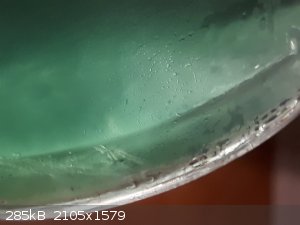
[Edited on 20-6-2019 by AJKOER]
|
|
|
AJKOER
Radically Dubious
    
Posts: 3026
Registered: 7-5-2011
Member Is Offline
Mood: No Mood
|
|
Here is a revised rendition of the reaction chain based on a microwave assisted preparation of CuSO4 in the presence of activated carbon for those
interested:
Cu = Cu(l) + e- (aq)
Cu(l) = Cu(ll) + e- (aq)
H2O2 = H+ + HO2-
H+ + e-(aq) = •H
•H + HO2- = •OH + OH-
2 HSO4- = 2 H+ + 2 SO4(2-)
•OH + SO4(2-) = OH- + •SO4-
2 H+ + 2 OH- = 2 H2O
•SO4- + e-(aq) = SO4(2-)
----------------------------------------
Employing NaHSO4 as the source of the bisulfate, the net reaction would be:
Cu + H2O2 + 2 NaHSO4 ---Activated Carbon, Microwave---> CuSO4 + Na2SO4 + 2 H2O
where the expected k > 10^8 (based on p. 15 reported reactions by •SO4- acting on Fe(ll), Ce(lll), Cr(ll),.. at https://srd.nist.gov/NSRDS/NSRDS-NBS-65.pdf by Ross and Neta)
[Edited on 5-7-2019 by AJKOER]
|
|
|
Ubya
International Hazard
    
Posts: 1247
Registered: 23-11-2017
Location: Rome-Italy
Member Is Offline
Mood: I'm a maddo scientisto!!!
|
|
you should try to make some phenol
https://www.sciencedirect.com/science/article/abs/pii/001078...
---------------------------------------------------------------------
feel free to correct my grammar, or any mistakes i make
---------------------------------------------------------------------
|
|
|
AJKOER
Radically Dubious
    
Posts: 3026
Registered: 7-5-2011
Member Is Offline
Mood: No Mood
|
|
Ubya:
Quoting from the article you cited:
"When a strip of metallic copper is incubated in the presence of physiological saline, both cuprous and cupric ions are produced. The reaction
requires both saline and oxygen.....
On oxidation of cuprous, free radicals are produced. This is shown by the initiation of polymerization of acrylamide both by incubation with copper
metal (EDTA being present) or directly with cuprous chloride. Substances which inhibit cuprous formation suppress the polymerization.
Incubation of copper in a benzene-saturated saline solution yields phenol showing that hydroxyl free radicals are produced."
Apparently, based on the literature, Cl- in the presence of copper ions and H2O2 produces small amounts of HOCl (see 'Copper ions and hydrogen
peroxide form hypochlorite from NaCl thereby mimicking myeloperoxidase' by Frenkel at https://www.ncbi.nlm.nih.gov/pubmed/3009503). Then, reaction between cuprous and HOCl forms a fenton-type reaction, best discussed in steps,
leading to the reportedly observed hydroxyl radical, •OH, creation:
Cu = Cu(l) + e-
Cu(l) = Cu(ll) + e-
HOCl + e- = •ClOH- (see, page 13, Table 1.2a at https://www.bnl.gov/isd/documents/92710.pdf and Supplement Table S1, link below, Reaction [1] )
•ClOH- <--> Cl- + •OH (pH > 5, see Eq(8), page 8, same source as above)
Also, different radicals and products at low pH:
•ClOH- + H+ = H2O + •Cl (pH < 5, k = 2.1×10^10 Source: Eq (7) in Supplement Table S1 at: http://www.mdpi.com/1420-3049/22/10/1684 and click on Supplement F1 to download)
And, with increasing chloride presence (not likely in the current situation):
•Cl + Cl- = •Cl2- (Eq(8) per above)
The radicals, especially •OH attack and breakdown organic compounds. A slow reaction is good here as it limits the extent of the breakdown products
created (in other words, the first product of interest is not further reduced or removed timely).
Note, the article alludes to the employment of O2 (and not H2O2), Cu and dilute NaCl. The diluted salt presence facilitates the creation of dissolved
oxygen from contact with air or pure oxygen. The added presence of electrons (perhaps from the colloidal nature of the mix and light,..., see
educational comments on colloidal charge at: https://hemantmore.org.in/science/chemistry/coagulation/1305...) could lead to superoxide, or perhaps acting in a manner similar to a suspension
of FeS2 (see 'Lactate oxidation in pyrite suspension: A Fenton-like process in situ generating H2O2' at https://www.sciencedirect.com/science/article/pii/S004565351... ):
O2(d) + e- (d) = •O2-
As a gas, the superoxide in the presence of water vapor behaves like •HO2 (see http://www.sciencemadness.org/talk/viewthread.php?tid=81667#... and cited references) and in the further presence of e- and water vapor, some H2O2
is possible:
e- + •HO2 --> HO2-
HO2- + H+ (readily taken from water vapor) --> H2O2
Likely all of the above likely proceeds in very low dosage reactions involving possibly an array of chemistry (fenton chemistry, surface chemistry,
chemistry of aerosols and properties of colloidal dispersions,...) so not really a path to harvesting breakdown products from benzene, and I would
guess not likely simple in nature either.
[Edited on 5-7-2019 by AJKOER]
|
|
|
|